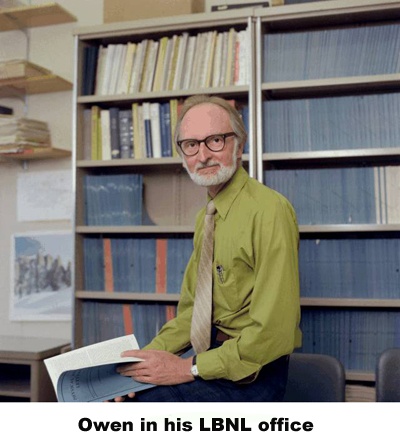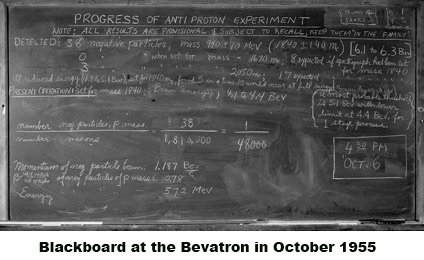Owen Chamberlain Biography
Owen Chamberlain
| Owen Chamberlain was a native of San Francisco. He obtained his bachelor’s degree at Dartmouth College in 1941 and entered graduate school at the University of California, but interrupted his study due to WWII, going to work on the Manhattan Project under Emilio Segrè.
In 1946 he resumed graduate school at the University of Chicago under Enrico Fermi. He returned to Berkeley in 1948, with a teaching position at UC, and joined Lawrence’s “Rad Lab”, where he worked on proton-proton scattering experiments at the Berkeley Bevatron. In 1955 he participated with Clyde Wiegand, Emilo Segrè, and Thomas Ypsilantis in the discovery of the antiproton. The discovery was made possible through the combination of the Bevatron accelerator, the world’s most powerful at that time, and a unique detector, designed by Chamberlain and Wiegand, that was set off only by particles moving at the speed predicted for antiprotons. The antiproton experiments began the first week of August in 1955. |
 |
| On September 21st, the team got their first evidence of the antiproton based on measurements of particle momentum and velocity. The paper announcing their historic discovery was published in the November 1, 1955 issue of Physical Review Letters. It was reported the following day in the New York Times under the headline: “New Atom Particle Found; Termed a Negative Proton.”
Following the discovery he moved on to study the interactions of antiprotons with hydrogen and deuterium, the production of antineutrons from antiprotons, and the scattering of pi mesons. He was awarded a Guggenheim fellowship in 1957 for the purpose of doing studies in the physics of antinucleons at the University of Rome. In the 1960s, he led a pioneering exploration of the relationships between nuclear forces and the spin of protons and neutrons, that lasted some twenty years. |
| In the late 1970s and early 1980s, prior to his official retirement, he was an active member of the group of Berkeley Lab scientists, led by David Nygren, who developed the Time Projection Chamber, or TPC. In his later years he also became an outspoken activist for nuclear arms control and other issues of social concern. In the 1960s Chamberlain was a supporter of the Free Speech Movement at UC Berkeley, and a strong advocate for increased minority recruitment and enrollment there. He spoke out against the repression of scientists in the former Soviet Union, demonstrated against the Vietnam War, and was a founder of the nuclear freeze movement of the early 1980s. |  |